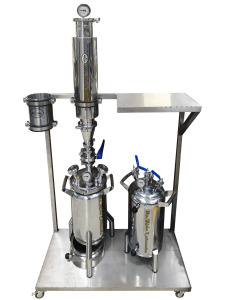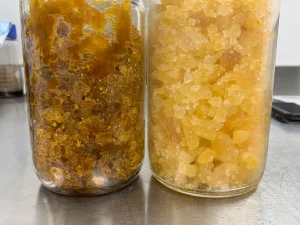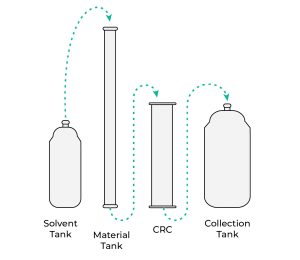Written By: Ashley Meza
One of the biggest things that frequent dabbers look at in concentrates is the color of the oil. Typically, the lighter the color, the better the quality. Older cannabis plants that are at a lower quality will produce a darker concentrate compared to fresher material that would produce a lighter colored concentrate. However, thanks to CRC tech and the overall advancement in technology in the concentrate world, it’s gotten harder to abide by that fact.
What is CRC Tech
 Color Remediation Column, or CRC, technology, is a new form of hash pressing and it applies mainly to butane hash oil extraction. This process filters impurities in the concentrate by using butane, butane blends, or alcohol as a solvent to separate oils from the cannabis plant.
Color Remediation Column, or CRC, technology, is a new form of hash pressing and it applies mainly to butane hash oil extraction. This process filters impurities in the concentrate by using butane, butane blends, or alcohol as a solvent to separate oils from the cannabis plant.
What CRC tech does is change low quality hash oil from a dark brown color to a light gold color by filtering out impurities. CRC alters a low-grade hash oil from a dark brown color to light gold, sometimes even reaching white. This is what makes it hard to follow the rule that the color of the wax is dictated by the freshness of the plant.
There is a wide variety of materials that can go in to the filtration process like, activated charcoal or alumina, bentonite clay, magnesol, silica, diatomaceous earth, and more, usually a combination of different substances is used. With CRC tech, cannabis oil is pressurized through a metal column where it is dissolved in one of the solutions listed above.
Controversy With CRC Tech
 CRC tech is legal in all compliant concentrate labs and cannabis companies, and it is safe to consume. However, just like with most new technology, CRC tech has provoked a controversy. There are people who believe that it is a safe and a good alternative to get better quality wax at a lower price while others claim it makes low-grade distillate concentrate appear as top shelf live resin.
CRC tech is legal in all compliant concentrate labs and cannabis companies, and it is safe to consume. However, just like with most new technology, CRC tech has provoked a controversy. There are people who believe that it is a safe and a good alternative to get better quality wax at a lower price while others claim it makes low-grade distillate concentrate appear as top shelf live resin.
The biggest debate on this tech is the fact that testing is not necessary in labs that use this method of filtration. Because of this, many companies end up using trim and/or unsuccessful products — meaning that they could have pesticides, mold, or other contaminants that cannot be used for consumption — to create concentrates through CRC technology. One thing that has become a problem with this technology is that when the cannabis is put through, it can lose a lot of the natural terpenes and many companies will artificially add them back into the product.
A Need For Transparency
 It seems that the biggest problem with CRC technology stands in the transparency of a company. Since states do not require for CRC tech to be advertised, consumers do not necessarily know what the quality of the concentrate was before getting to the final product nor if the product they are purchasing has derived terpenes added.
It seems that the biggest problem with CRC technology stands in the transparency of a company. Since states do not require for CRC tech to be advertised, consumers do not necessarily know what the quality of the concentrate was before getting to the final product nor if the product they are purchasing has derived terpenes added.
CRC tech is not necessarily a bad thing, many benefits can come from cleaning up some of the crop, like taking out lipids or chlorophyll molecules. The problems persist when labs are dishonest about what’s in their end result by using those unsuccessful products. On top of that, there is a lack of safety regulations to prevent companies from practicing this.
Since there are no safety regulations nor disclosure agreements, many hashmakers have their own method of using Color Remediation Column technology; which is what can unfortunately result in them taking advantage of that fact by practicing using failed product. The downside is that these companies can up-market the final product by pricing them higher than what the quality actually is. However, CRC tech is still pretty new to the cannabis world and not every manufacturer uses it.
At the end of the day, the dabbers deserve to be aware of that information in its entirety so that they can make an informed decision on what they are purchasing. Since this tech is so new, there is still room to grow both in technological advances and safety measures. For now, asking your local budtender which farms are better quality and a more transparent as a company, or doing research of your own, can help you make an informed choice on what to dab on.
You can also always stop by your local Nectar (of course) for wax that is undeniably high quality. We carry some of the top concentrates brands such as Oregrown, Higher Cultures, and The Refinery. They provide amazing wax that you can be sure was made with absolute care, and after one taste from these brands, you’ll see what I mean!



